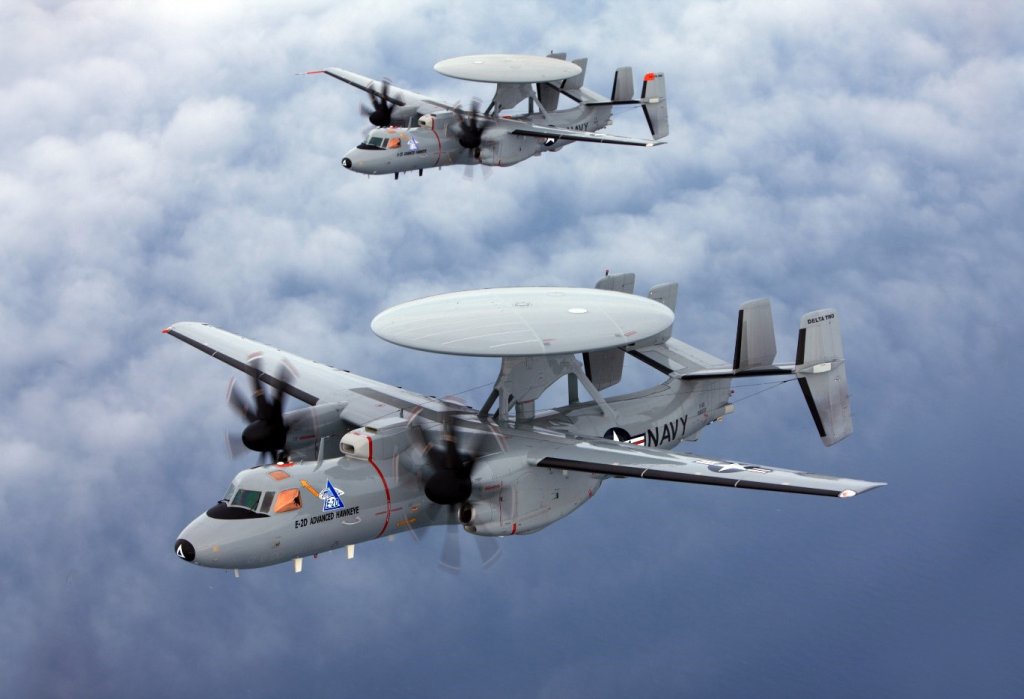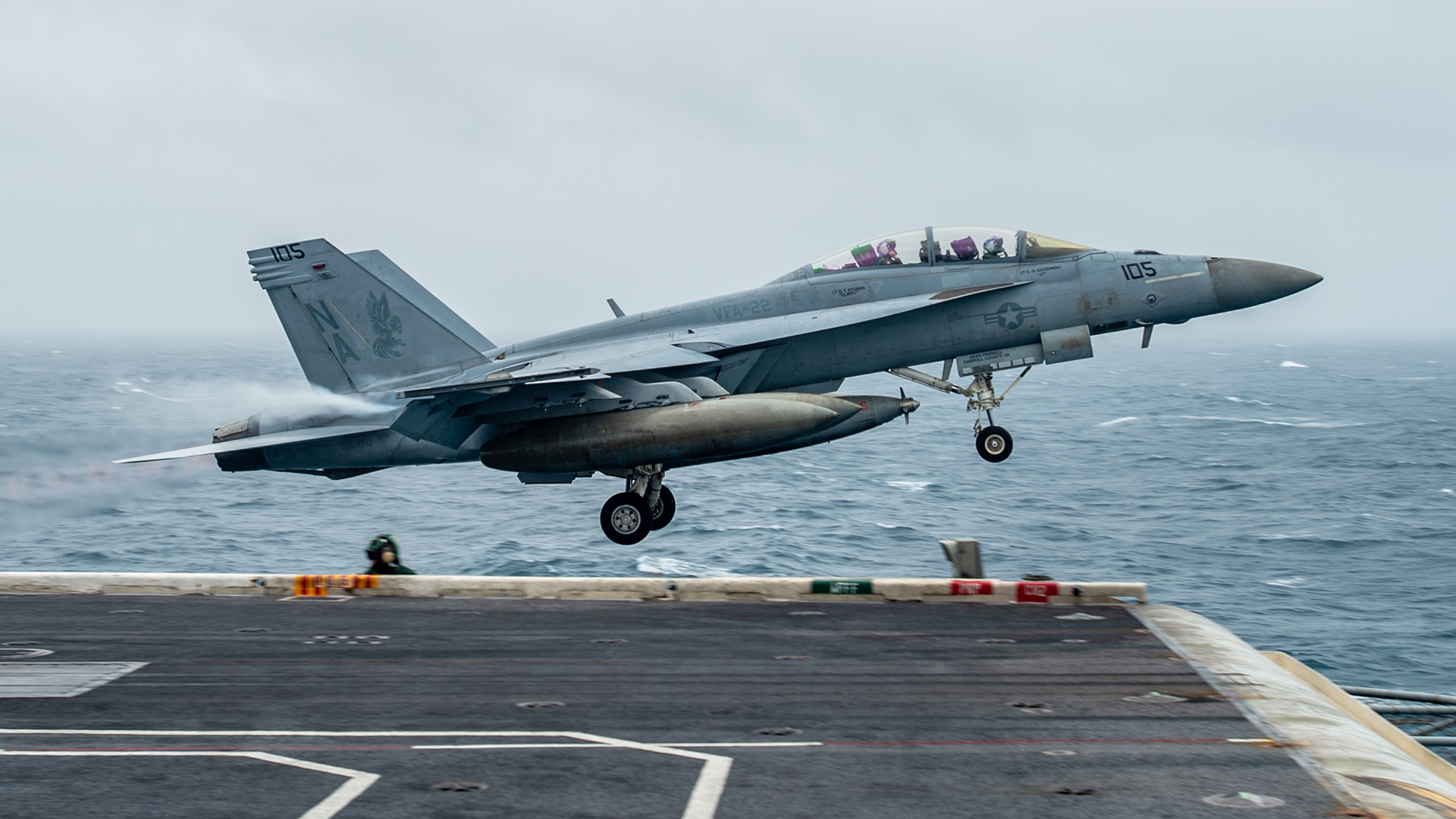A U.S. Navy F/A-18F Super Hornet was conducting a refueling mission over the Red Sea when it was downed in a friendly fire incident this past weekend. The Ticonderoga class USS Gettysburg fired on the jet for reasons that are now under investigation. That cruiser also happens to be the first of its class to have gone through a deep modernization program that includes significant upgrades to its air defense suite, making it the most advanced operational example of its dwindling class.
Author’s note: We have new information on this event that you can check out in our latest post here after getting up to speed with the current article you are reading.
“The [F/A-18F] aircraft is part of Carrier Airwing (CVW) 1 and was performing a refueling mission,” the Navy’s Naval Air Force Atlantic (AIRLANT) said in a statement to TWZ earlier today. We have reached out for further clarification about whether the two-seat Super Hornet was acting as the tanker and/or whether it was linked to another aircraft at the time of the shoot down.

USS Gettysburg engaged and brought down the F/A-18F on Dec. 22 local time, according to a previously released statement from U.S. Central Command (CENTCOM). Gettysburg and CVW-1 are both currently assigned to the Harry S. Truman Carrier Strike Group.
Truman, its air wing, and its escorts had just entered the Red Sea last week. The strike group is currently supporting operations to protect friendly military assets from attacks by Iranian-backed Houthi militants in Yemen, including strikes ashore.
“Both pilots were safely recovered,” CENTCOM’s prior statement added. “Initial assessments indicate that one of the crew members sustained minor injuries. This incident was not the result of hostile fire, and a full investigation is underway.”
“Pilots” here looks to be a misnomer. The individual flying in the backseat of an F/A-18F is typically a Weapon Systems Officer (WSO), not a second pilot, and this was reportedly the case in this instance, according to The Washington Post‘s Dan Lamothe.
Lamothe also reported, citing an anonymous military official, that a Standard Missile-2 (SM-2) was the weapon Gettysburg fired that brought down the Super Hornet, two crew members had both suffered minor injuries, and the Navy is considering whether or not to recover the wreckage.
The SM-2 family is a key element of the Navy’s arsenal of ship-launched surface-to-air missiles. Since October 2023, SM-2s have been weapons of choice for U.S. naval forces in the Middle East for engaging Houthi missiles and drones. In addition, Ticonderoga class cruisers currently act as the central air and missile defense node for the Navy carrier strike group.
Whether or not to attempt to retrieve any portion of the downed F/A-18F will be an important question for the Navy. As TWZ has highlighted many times in the past, adversaries could try to do the same and glean useful intelligence from whatever they recover.
When it comes to refueling missions, F/A-18 Super Hornets are currently routinely employed as tankers for other aircraft in Navy carrier air wings, typically flying stable orbits relatively close to the strike group for recovery operations, but are also used to refuel jets after launch or on their way to their objectives. They execute this in the ‘5-wet’ configuration, with four 480-gallon fuel tanks and a centerline hose-and-drogue refueling pod.
The services plans to supplant Super Hornets in this role with a new fleet of MQ-25 Stingray aerial refueling drones, which will also have secondary intelligence, surveillance, and reconnaissance capabilities and could take on other missions in the future. Unfortunately, the MQ-25 program has been beset by delays and other issues, and Stingrays are not expected to begin flying operational missions until at least 2026. Land-based tanker aircraft also regularly support Navy carrier-based aircraft.

While few other details regarding this past weekend’s friendly fire incident have emerged, a lot of things can go wrong and cause fratricide in such an environment, according to Bradley Martin, a retired surface warfare officer (SWO) who spent two-thirds of his 30-year Navy career at sea.
“Aircraft might not have had its identification on,” he told TWZ Monday. “The profile that was being reported in the Aegis system might have looked like a threat, so the operators are looking at it and trying to determine what they’re seeing and make a decision in fairly short order.”
Battle management combat systems like Aegis are not perfect, Martin said. “They occasionally misreport things or cause dual tracks, or they’ll not correctly identify something,” he continued, adding that sometimes it’s a combination of equipment and operator error.

Near-misses happen “all the time,” Martin added, where an operator is looking at a screen and trying to figure out what they are seeing in a very short period of time.
“Especially when you’re dealing with a wartime environment,” he noted. ‘The Navy’s fired a lot of missiles in the last year, more than it has in decades.”
TWZ has previously noted how the Houthi’s very active campaign targeting ships in and around the Red Sea, combined with the congested nature of the operating environment in the region, raises the risks of accidental shootdowns. Just in February, a German Navy warship sailing in the Red Sea fired on a U.S. MQ-9 Reaper drone, but did not bring it down, in a case of mistaken identity.
There are many other instances of aircraft being accidentally damaged or shot down, especially in the midst of active conflicts. The now-decommissioned Ticonderoga class cruiser USS Vincennes was involved in a particularly infamous incident in the midst of the Iran-Iraq War in 1988 where it shot down Iran Air Flight 655, killing everyone onboard. Issues with the Aegis Combat System’s user interface at the time, as well as stress, timing, and confusion, have been cited as contributing factors.
Thanks to a major upgrade program, the Aegis system on Gettysburg is one of the most modern currently in service, as you can read more about here. Unlike Vincennes in 1988, the cruiser also has the benefit of a much more advanced overall sensor suite with deep networking and sensor fusion capabilities on top of its far more advanced Aegis system. Decades of evolutionary enhancements have made it a very different combination of capabilities than it was nearly four decades ago.
That the Super Hornet was apparently in the midst of a relatively low-performance and predictable refueling mission and the Gettysburg’s capabilities, coupled with the ship’s key air defense command and control role for the strike group, makes this shootdown all the more puzzling. At the same time, we don’t know what systems were operating on the ship at the time of the friendly fire incident this weekend or what other sources of data, such as from an E-2 Hawkeye airborne early warning and control aircraft and other ships in the region, might have been available to feed into the crew’s overall picture of the battlespace.

As the retired SWO Martin highlighted, the current situation U.S. forces are contending with in the Red Sea is an extremely high-threat environment with multiple layers of threats, some of which can be very hard to detect and categorize. The Houthis are actively targeting American warships, as well as commercial vessels, with various aerial drones, cruise missiles, anti-ship ballistic missiles and unmanned surface vessels, often simultaneously. The available time in which to make potentially serious decisions can be measured in seconds.
The friendly fire incident also shined a new and unwelcome light on the Ticonderoga class’s woes, including when it comes to the much-maligned modernization program for a handful of the remaining ships. The original plan had been to substantially upgrade 11 of the cruisers, which would serve in the 2030s.

However, as it stands now, only three Ticonderogas will be modernized – USS Gettysburg, USS Chosin, and USS Cape St. George – and they may only deploy once more each before their scheduled decommissioning dates in the coming years. A report from GAO, a Congressional watchdog, published earlier this month, described the cruiser modernization effort as a poster child for how not to run such an effort, saying that around $1.84 billion had been wasted on modifications to ships that never returned to sea.
The report also highlighted issues with Gettysburg, specifically, post-modernization and in the run-up to its current deployment.
“USS Gettysburg completed its modernization, including sea trials, in February 2023. The Navy’s Board of Inspection and Survey determined the ship meets the minimum standard to get to sea,” according to GAO. “However, in January 2024 the Navy’s Board of Inspection and Survey identified several outstanding issues during an inspection of the ship’s condition. For example, several elements of the weapons systems were inoperable or degraded and there were structural issues throughout the ship. Since the inspection, the Navy has addressed several of these issues and the ship completed 18 days at sea in June 2024 in preparation for deployment. During this time at sea, USS Gettysburg completed a successful missile launch and intercept using its updated combat systems software.”
“The Navy deployed USS Gettysburg in September 2024 with its carrier strike group. Prior to the deployment, the ship’s crew told us that parts continued to be a problem, including steering gears and hydraulic power unit solenoid valves, among others,” GAO’s report added. “To address this problem, the Navy used parts from the decommissioned cruisers. According to the ship’s crew, propulsion plant and electric system failures were key concerns for the USS Gettysburg deployment.”

GAO said the Navy was looking to see how Gettysburg performed on its latest deployment before making any decisions about whether to send it out again before decommissioning it. The service has long said now that the Ticonderoga class as a whole has become increasingly unreliable and the ships have been suffering from hull cracking and other structural issues for years already.
It is important to stress again that the chain of events that led to Gettysburg bringing down the Super Hornet over the Red Sea remains unknown, including whether or not any issues with the ship itself played a role.
“This kind of mistake sadly is almost inevitable,” Martin, the retired SWO, told TWZ. “A sky full of aircraft, some friendly, a lot not friendly, ships trying to sort out occasionally ambiguous situations under a great deal of time pressure. These things will almost inevitably occur.”
Martin said everyone should recognize these things can and do happen in an intense-enough combat environment, and that the Navy needs to be transparent about what happened.
“The public, the media, me, would be willing to accept that these things happen, this was an accident and [the Navy] has done something to prevent it,” he said. “Fortunately, in this case, it wasn’t a tragedy, it was just a loss of an expensive airplane.”
The Navy is just at the start of its investigation into the friendly fire incident and more details about exactly what happened could emerge as that effort gets more underway. As Martin notes, in this instance, thankfully the two aviators onboard the F/A-18F were able to safely eject.
Contact the author: joe@twz.com
